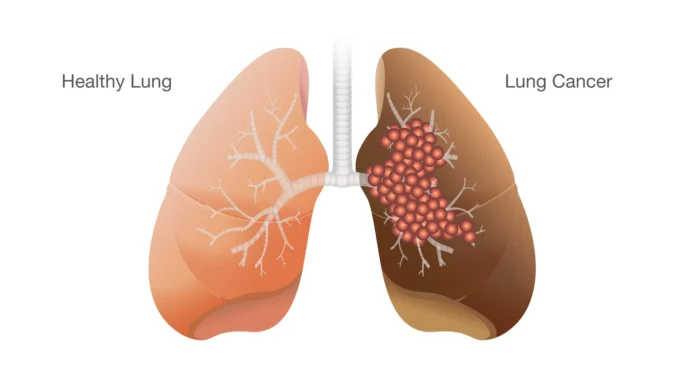Lung Cancer, a disease marked by cells growing in the lungs, ranks as the third most widespread cancer in the United States posing a major threat to public health. Grasping the different varieties warning signs, dangers, and treatments is vital for spotting it and handling it well.

Varieties of Lung Cancer
Here’s a breakdown of the main types of lung cancer:
- Non-Small Cell Lung Cancer (NSCLC): NSCLC makes up more than 80% of lung cancer cases, including types like adenocarcinoma squamous cell carcinoma, and large cell carcinoma. Most often, you’ll find adenocarcinoma in the lungs’ outer areas.
- Small Cell Lung Cancer (SCLC): Though not as common SCLC is way more fierce. It grows fast and spreads through the body. There’s a strong connection to smoking with SCLC, and it kicks off in the lungs’ central passages.
Symptoms of Lung Cancer
The signs of lung cancer might change with its type and where it’s at in its journey. You might see stuff like:
- A cough that doesn’t quit and gets meaner as time goes by.
- Chest hurts or feels weird.
- It’s tough to catch your breath.
- A whistling sound when you breathe.
- Spitting out blood when you cough.
- Losing weight when you’re not even trying.
- Feeling tired all the time.
Gotta remember though, these signs might have to do with other health stuff too. But, if these things are happening to you, and you’ve smoked before have a chat with someone who knows their medical stuff, and do it quick.
**Things That Make Lung Cancer More **
A bunch of stuff can crank up your chances of getting lung cancer:
- Smoking: It causes most lung cancer cases about 80%. The risk goes up with the number of cigarettes and the years of smoking.
- Secondhand Smoke Exposure: Even if you don’t smoke being around it can raise your chances.
- Radon Exposure: This sneaky radioactive gas can sneak into buildings and boost lung cancer odds.
- Asbestos Exposure: Working with asbestos can kick up fibers that mess with your lungs.
- Family History: Having relatives with lung cancer can up your own risk.
- Radiation Therapy: If you’ve had radiation in your chest area for other cancers, it could hike up the likelihood of lung cancer.
Knowledge of these risks is crucial to stop and spot early signs.
Diagnosis
If detected , treatment outcomes for lung cancer get a big boost. Diagnosing might involve:
- “Imaging Tests”: “Chest X-rays” and “CT scans” help spot strange masses or blobs in the lungs.
- “Sputum Cytology”: Looking at sputum with a microscope can spot cells from lung cancer at times.
- “Biopsy”: Taking out a piece of weird tissue to check in the lab is the sure shot way to know if it’s lung cancer.
People who are at risk, like heavy smokers, should get checked. “Low-dose CT scans” are the go-to for these checks.
Treatment options
Lung cancer treatment hinges on the specific type, stage, and the patient’s general health. Usual treatment methods cover:
- Surgery: Doctors often take out the tumor and the nearby tissue as a first step to tackle early-stage NSCLC.
- Radiation Therapy: Docs use power-packed beams aiming to destroy cancer cells. This can be the main treatment or an extra step after surgery to get rid of any cells left.
- Chemotherapy: This approach uses medicine to annihilate cancer cells. People with both NSCLC and SCLC receive this treatment.
- Targeted Therapy: This zeros in on the unique genetic changes in cancer cells to tailor the treatment.
- Immunotherapy: This method boosts the immune system to combat cancer cells and it’s showing solid results in some lung cancer battles.
These treatment upgrades have helped drop the number of deaths from lung cancer .
Prevention
Reducing lung cancer risk needs preventive steps:
- No Smoking: To defend against lung cancer best to never light up or quit if you’re already a smoker.
- Radon Checks: Get your home checked for radon and take action if the amounts are too much.
- Steer Clear of Carcinogens: Try to avoid bad stuff like asbestos and diesel fumes at work.
- Eat Healthy: Lots of fruits and veggies might lower your chances of getting cancer.
- Stay Active: Regular workouts keep you fit and might cut down your cancer risk.
Putting these methods into play could cut down on the chances of getting lung cancer.
Wrap-up
Lung cancer’s still a super big health problem, but getting the lowdown on the different kinds, signs stuff that ups the risk, and ways to treat it can help catch it quick and make things better for folks. Quitting smoking is like a big deal if you wanna drop the number of people getting this sickness. Making sure you hit up your doc and stick to their advice on tests is pretty much key to keeping your lungs in good shape.

